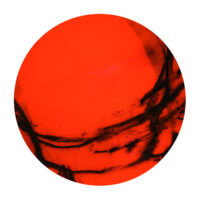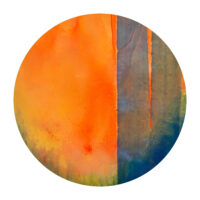In feeling, the soul forms a space for itself. Feeling opens up dimensions for it. The world becomes colored within it.
It happens when you read the first lines of this text, and it happens more subtly every time you open your eyes or fresh air flows in through your nose: inside and outside, I and the world, meet. What the soul encounters in this way it responds to with feeling. If we were composers, a melody would resound in our ears with this surging from inside and outside; if we were painters, it would be a brushstroke. It is our hustle and bustle, the clamor of everyday life, that causes this constantly sung inner song to ebb, to nearly fall silent—and yet, it is there! The soul begins to die when it stops producing this echo within itself. And this may be the most important insight: we ourselves create the feeling; we ourselves become angry, sad, happy, or afraid because of how we think about the world.
Elements of the Soul
“How are you?” Commonplace as it seems, this question is aimed at the core of our soul, at its interaction with the surrounding environment, which is what makes up the soul. Sometimes, it is harmonious, sometimes full of tension; sometimes, the environment invites us in, and sometimes, it rejects us. Feeling is the primal impulse to experience our own condition. Ever since life separated itself from the living sea and gave itself a skin, it learned to recognize its own condition and, thereby, to seek the most favorable environment in response to the separation. This is homeostasis, the power of life to bring the organism into balance. What leads the individual cell to move into the light whenever it experiences its absence flows as a feeling in our soul. It flows through us in four primary colors and, like the world to which it responds, is built from the elements of earth, water, air, and fire.
The feeling that makes us dance and fly when we say yes to everything, when we say yes to life, is like air. Outer and inner feel good, and therefore, everything is good—the feeling of joy flows through us. Every feeling has a power. Joy gives what air gives: vitality and attraction. The smiling faces on advertising posters show what joy brings with it as a shadow: superficiality and illusion.
How different the feeling is when the environment doesn’t correspond to our inner self, when “that’s not right!” is the conclusion. Then anger rises like fire in our limbs, and our heart pounds. Anger mobilizes the strength within us to eliminate whatever bothers us, to correct what we see as wrong. It can be harmless: a hand wiping across the lips to brush away a crumb of bread, or a hand reaching to the floor because a pen fell. Here, subtle anger is the trigger. Contradiction awakens anger, and anger awakens strength, clarity, and rightness. If the pendulum swings too far to the negative, this ordering becomes destructive.
But what happens when we realize that the world is different than we want it to be and we can’t fix it? Then it is not “wrong” we encounter, but “such a pity,” and what flows like water through the body as feeling is not anger but sadness. Grief gives the soul no less strength; it makes us able to accept what we cannot change and to say yes to what is beyond our will. From the morning glimpse of rain clouds on the horizon to heartbreak at the news of the loss of a friend—all are stages of regret and grief. This feeling gives us the strength to submit to what cannot be changed. The fruit that grows from it is humility, and with humility comes love. “He who has never eaten his bread with tears […],” Goethe assures us that grieving is part of the school of love. “Grieving yes, wailing no,” said singer-songwriter Reinhard Mey about the early death of his son. How wise: we should not put anger in the place of sadness.
What if the wrong that we encounter is so incomprehensible, so unfathomable, that we cannot change it, much less accept it? Then, the fourth feeling, the feeling of earth, comes into play: fear. Our breath becomes shallow, our skin cold. Just like with sadness, anger, and joy, our whole body takes part in the feeling. You stand on the three-meter board, the eyes of your classmates are on you, and you are supposed to jump. There is no going back and no going forward. Fear makes you tremble. What now? There is also a power lying dormant here: the power of transformation. You gather your courage and jump, and you become someone else in the leaping. Fear leads us to and over the threshold. This is where its power of transformation lies.

Feelings That Are Not Felt
I know a performer who asked his doctor to free him of his fear of the audience. The doctor said: “I can’t take away your stage fright, because it is what drives you to go from being an everyday person to being a person on stage. I can only help you to face this fear and transform it into courage.” However, we are not unique in rejecting sadness, fear, and anger as negative emotions. It’s the general attitude. We hope that the grieving father’s pain will soon subside, we urge the angry refugee to pull herself together, we soothe the anxious learner driver. It’s one and the same message: sadness, anger, and fear are negative feelings that get in the way of joy. But it’s not like that: sadness, anger, and fear are harmful when we don’t feel them, when we repress them, deny them, cover them up. Then they sink down, and the body stores them for us. It is part of the wisdom of life: feelings that overwhelm us are stored in the depths of our body and come to our consciousness again later to be felt and transformed into a force. If we don’t do this rumination of feelings, pain turns into suffering.
The Fifth Element
In the soul’s arithmetic of right and wrong environments, of acceptable and unbearable, there is a fifth option: the outer world seems coherent and right to us, but we ourselves feel wrong. “Who took the cake out of the fridge?” You shake your little head, but because your lips are still smeared with chocolate, you are busted. It’s one of the lessons of childhood; it’s the school of conscience—you will be caught in a lie, no matter how sweet it may be. Shame goes to the head, but unlike anger, where the wrong is happening outside, it is now inside. Shame is the only feeling that turns completely inward, judges us, lifts us up, and leads us to self-knowledge. Adam and Eve are ashamed, and this feeling sends them on their journey to become human. Joy, sadness, anger, and fear exist in the animal kingdom, but shame does not.
Feelings are arms of the soul. With hunger, tiredness, and even falling in love, the soul takes hold of and animates our body; with loyalty, humility, and love, it reaches up and animates the spirit. The soul takes hold of itself with joy, sadness, anger, fear, and shame. When we feel feelings, the soul grows, and then the feelings give us the power to transform ourselves, to transform everything.
Translation Laura Liska
Image The Goetheanum Weekly graphics team






This is a very clear and most inspiring way of explaining our feeling life! Thank you!!!